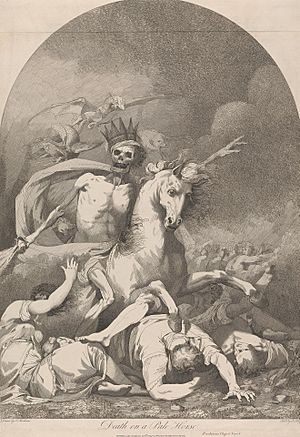Joseph Haynes (painter) facts for kids
Joseph Haynes (1760–1829) was an English artist. He was known for his paintings and for making special prints called etchings. He lived during the late 1700s and early 1800s.
Joseph Haynes's Life
Joseph Haynes was born in a town called Shrewsbury, England. He was baptized on February 20, 1761.
When he was young, Joseph moved to London. There, he learned art from a famous artist named John Hamilton Mortimer. After Mortimer passed away in 1779, Joseph Haynes helped share some of his teacher's artworks. He made etchings of about twelve of Mortimer's paintings. These included "Saint Paul Preaching to the Britons" and "Robbers and Banditti." These etchings were first shared between 1780 and 1784.
Joseph Haynes also created etchings of works by other well-known artists. In 1784, he made prints from four pictures by William Hogarth. These included "The Staymaker" and "Debates on Palmistry." He also etched portraits of important people like James Caulfeild, Earl of Charlemount and Henry Fox, Lord Holland. The person who owned these original portraits asked Haynes to make the etchings.
Haynes was also friends with Sir Joshua Reynolds, another very famous painter. Later, Joseph Haynes copied some of Reynolds's pictures.
At one point, Joseph Haynes traveled to Jamaica, but his trip was not successful. He then returned to Shrewsbury. Eventually, he settled in Chester, where he taught drawing. He passed away in Chester on December 14, 1829.
Joseph Haynes's Art Style
Joseph Haynes worked in a free and expressive style, much like his teacher, John Hamilton Mortimer. He often made his etchings quite large. Some of his prints were even made using red ink, not just black. He also worked in a printmaking technique called mezzotint.
Haynes did not create many paintings, and they are hard to find today. However, his etchings and engravings are quite numerous. Experts believe his etchings have a lot of artistic value. You can find prints by Joseph Haynes in important museums like the British Museum and the Victoria and Albert Museum.



